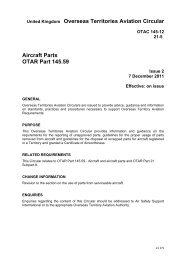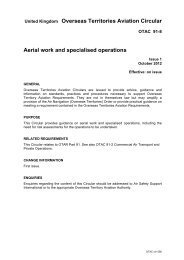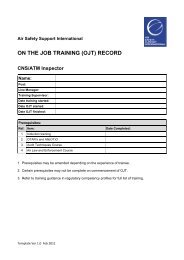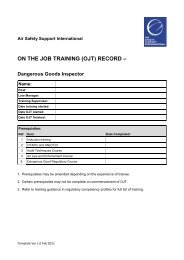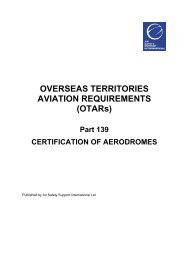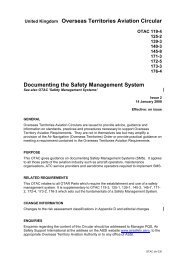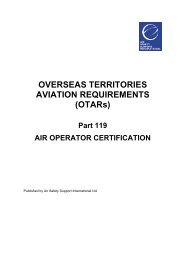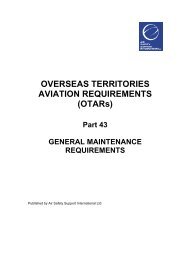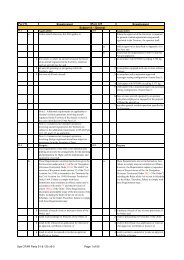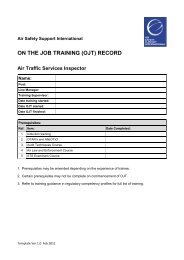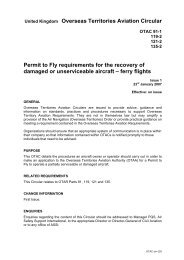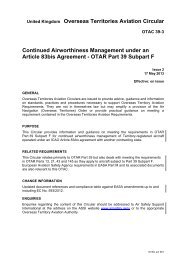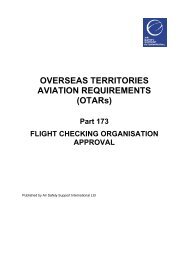OTAR Part 39 - Air Safety Support International
OTAR Part 39 - Air Safety Support International
OTAR Part 39 - Air Safety Support International
You also want an ePaper? Increase the reach of your titles
YUMPU automatically turns print PDFs into web optimized ePapers that Google loves.
OVERSEAS TERRITORIESAVIATION REQUIREMENTS(<strong>OTAR</strong>s)<strong>Part</strong> <strong>39</strong>CONTINUED AIRWORTHINESSREQUIREMENTSPublished by <strong>Air</strong> <strong>Safety</strong> <strong>Support</strong> <strong>International</strong> Ltd
© <strong>Air</strong> <strong>Safety</strong> <strong>Support</strong> <strong>International</strong> Limited 2004First Issue - published for information June 2004Second Issue – released for gazetting July 2005Third Issue July 2006Fourth Issue May 2007Fifth Issue May 2007Sixth Issue September 2009Seventh Issue April 2011The definitive version of <strong>OTAR</strong>s is that on the ASSI website www.airsafety.aero which shouldbe viewed to establish the issue version of each <strong>Part</strong>.Enquiries regarding the content of this publication should be addressed to:<strong>Air</strong> <strong>Safety</strong> <strong>Support</strong> <strong>International</strong>, Northgate House, 115 High Street, Crawley, West Sussex,RH10 1FY.www.airsafety.aero
Continued <strong>Air</strong>worthiness Requirements <strong>Part</strong> <strong>39</strong> Page iCHECKLIST OF PAGESPage no Issue no DateTitle page 7 April 2011Checklist of pages i 7 April 2011Revisions ii 7 April 2011Contents iii 7 April 2011Subpart A 1 7 April 20112 7 April 2011Subpart B 3 7 April 20114 7 April 20115 7 April 20116 7 April 20117 7 April 20118 7 April 2011Subpart C 9 7 April 201110 7 April 201111 7 April 201112 7 April 2011Subpart D 13 7 April 201114 7 April 201115 7 April 201116 7 April 201117 7 April 2011Subpart E 18 7 April 201119 7 April 201120 7 April 2011Subpart F 21 7 April 2011<strong>Air</strong> <strong>Safety</strong> <strong>Support</strong> <strong>International</strong> (ASSI) Issue 7 Overseas Territories Aviation Requirements
Continued <strong>Air</strong>worthiness Requirements <strong>Part</strong> <strong>39</strong> Page iiREVISIONS<strong>OTAR</strong> IssueSubjectIssue 1First issue published for information.Issue 2Second issue for gazetting. Change to title of <strong>Part</strong> and toPurpose statement.Issue 3Substantial revision by the inclusion of the continuedairworthiness elements derived from the operational<strong>OTAR</strong>s and title change reflecting new scope of <strong>Part</strong>.Issue 4Addition of Subpart E and associated supportingamendments throughout the <strong>OTAR</strong> <strong>Part</strong>. Reordering ofsome paragraphs.Issue 5 Correction of cross-references <strong>39</strong>.1 and <strong>39</strong>.61.Issue 6Minor changes taking account of current airworthinessissues and consultation comments. Addition of Subpart Fapproval relating to foreign commercial operations ofTerritory-registered aircraft under an ICAO Article 83bisagreement. There are other minor changes toaccommodate this new Subpart.Issue 7Introduction of quality system, Accountable Manager,removal of approval from Subpart F and minor technicaland editorial changes.<strong>Air</strong> <strong>Safety</strong> <strong>Support</strong> <strong>International</strong> (ASSI) Issue 7 Overseas Territories Aviation Requirements
Continued <strong>Air</strong>worthiness Requirements <strong>Part</strong> <strong>39</strong> Page iiiContentsCHECKLIST OF PAGES...............................................................................................................iREVISIONS....................................................................................................................................iiSUBPART A — GENERAL...........................................................................................................1<strong>39</strong>.1 PURPOSE........................................................................................................ 1<strong>39</strong>.3 DEFINITIONS ................................................................................................... 2SUBPART B — CONTINUED AIRWORTHINESS MANAGEMENT............................................3<strong>39</strong>.51 MANAGEMENT PERSONNEL.............................................................................. 3<strong>39</strong>.53 GENERAL CONTINUED AIRWORTHINESS ARRANGEMENTS .................................. 3<strong>39</strong>.55 MANAGEMENT RESPONSIBILITIES ..................................................................... 4<strong>39</strong>.57 GENERAL MAINTENANCE ARRANGEMENTS ........................................................ 6<strong>39</strong>.59 MAINTENANCE CONTROL MANUAL ................................................................... 6SUBPART C — INSPECTION REQUIREMENTS ........................................................................9<strong>39</strong>.61 MAINTENANCE PROGRAMME ............................................................................ 9<strong>39</strong>.63 MAINTENANCE PROGRAMME APPROVAL ........................................................... 11<strong>39</strong>.65 CONDITION MONITORED AND RELIABILITY MAINTENANCE PROGRAMMES............. 11<strong>39</strong>.67 AIRWORTHINESS DIRECTIVES APPLICABILITY .................................................... 12<strong>39</strong>.69 AIRWORTHINESS DIRECTIVES COMPLIANCE ...................................................... 12<strong>39</strong>.70 CONTINUED AIRWORTHINESS IMPROVEMENTS .................................................. 12<strong>39</strong>.71 ALTERNATIVE MEANS OF COMPLIANCE WITH MANDATORY CONTINUEDAIRWORTHINESS REQUIREMENTS ..................................................................... 12SUBPART D — AIRCRAFT RECORDS .......................................................................................13<strong>39</strong>.73 MAINTENANCE AND CONTINUED AIRWORTHINESS RECORDS .............................. 13<strong>39</strong>.75 RETENTION OF RECORDS................................................................................. 14<strong>39</strong>.77 TRANSFER OF MAINTENANCE RECORDS............................................................ 15<strong>39</strong>.79 TECHNICAL LOG .............................................................................................. 15<strong>39</strong>.81 MASS AND BALANCE........................................................................................ 16<strong>39</strong>.83 ALTERNATIVE CONFIGURATIONS....................................................................... 16<strong>39</strong>.85 CERTIFICATION ............................................................................................... 17SUBPART E — CONTINUED AIRWORTHINESS MANAGEMENT APPROVAL .......................18<strong>39</strong>.87 APPLICABILITY................................................................................................. 18<strong>39</strong>.89 STANDARDS.................................................................................................... 18<strong>39</strong>.91 ISSUE ............................................................................................................. 18<strong>39</strong>.93 PRIVILEGES OF APPROVAL HOLDER.................................................................. 19<strong>39</strong>.95 DURATION OF APPROVAL ................................................................................. 19<strong>39</strong>.97 NOTIFICATION OF CEASING APPROVAL ACTIVITY................................................ 19<strong>39</strong>.99 RENEWAL OF APPROVAL.................................................................................. 19<strong>39</strong>.101 CONTINUED COMPLIANCE ................................................................................ 19SUBPART F — CONTINUED AIRWORTHINESS MANAGEMENT IN ASSOCIATION WITH AN ICAOARTICLE 83BIS AGREEMENT ....................................................................................................21<strong>39</strong>.103 APPLICABILITY................................................................................................. 21<strong>39</strong>.105 STANDARDS.................................................................................................... 21<strong>39</strong>.107 COMPLIANCE................................................................................................... 21<strong>Air</strong> <strong>Safety</strong> <strong>Support</strong> <strong>International</strong> (ASSI) Issue 7 Overseas Territories Aviation Requirements
Continued <strong>Air</strong>worthiness Requirements <strong>Part</strong> <strong>39</strong> Page 1Subpart A — General<strong>39</strong>.1 Purpose(a)(b)(c)This <strong>Part</strong> details requirements governing aircraft registered in the Territoryand issued with an airworthiness certificate under <strong>Part</strong> 21 Subpart E andany aeronautical product associated with those aircraft.The holder of an air operators certificate or the owner or lessee of anaircraft above 2,700 kg MTOM shall have arrangements for continuedairworthiness management to the requirements of Subpart E of this <strong>OTAR</strong><strong>Part</strong>.The requirements of this <strong>OTAR</strong> <strong>Part</strong> cover the grant and renewal ofcontinued airworthiness inspection programmes and managementapprovals. These are the approval options under this <strong>OTAR</strong> <strong>Part</strong>:(1) Subpart E Option 1: the approval of an organisation based on theacceptance of the European Aviation <strong>Safety</strong> Agency (EASA)requirements of <strong>Part</strong> M Subpart G and the EASA regulatoryoversight of that organisation.(2) Subpart E Option 2: the approval of an organisation that does nothold an approval identified in paragraph <strong>39</strong>.1(c)(1).(d)Subpart F is a standard of continued airworthiness management requiredfor Territory-registered aircraft operating under a foreign air operatorcertificate and subject to an ICAO Article 83bis agreement with theTerritory.(e) Throughout this <strong>Part</strong> reference is made to the options identified inparagraph <strong>39</strong>.1(c)(1) and (2). The options are not at the discretion of anapplicant but are routes that depend on the existing approval status of anorganisation and are determined by the OTAA.(f)These requirements are not in themselves Law. Failure to comply may notconstitute an offence. However, the requirements reproduce many of theprovisions of the <strong>Air</strong> Navigation (Overseas Territories) Order 2007 (asamended) (“the Order”). Therefore, failure to comply with theseRequirements may:(1) constitute a breach of the Order; and(2) result in proceedings for breaches of the Order; or(3) result in the refusal of an application for renewal of an approval; or(4) result in action to suspend or revoke an approval.(g)The Order details the legal obligations governing the continuedairworthiness of aircraft on the Territory’s register. The Order specifiesthese obligations in rather general terms, therefore there is a provision inArticle 41 and 152 to the Order which requires the Governor to publishRequirements to augment, amplify and detail more precisely the manner<strong>Air</strong> <strong>Safety</strong> <strong>Support</strong> <strong>International</strong> (ASSI) Issue 7 Overseas Territories Aviation Requirements
Continued <strong>Air</strong>worthiness Requirements <strong>Part</strong> <strong>39</strong> Page 2in which these obligations shall be met. The Requirements are the meansby which the operator or maintenance organisation will be able to satisfythe Governor as to the fulfilment of the obligations in respect of continuedairworthiness and the entitlement of the holder to hold and exercise theprivileges of a certificate, licence or approval.(h)(i)Other <strong>OTAR</strong> <strong>Part</strong>s, in addition to that referred to in this <strong>Part</strong>, may impingeupon activities conducted under this <strong>Part</strong>. In particular, <strong>Part</strong> 1 containsdefinitions, which apply, unless otherwise stated, to all <strong>Part</strong>s. A full list of<strong>OTAR</strong> <strong>Part</strong>s, a description of the legislative structure and the place of<strong>OTAR</strong>s and OTACs within it can be viewed on the ASSI websitewww.airsafety.aero. OTACs relevant to this <strong>Part</strong> can be viewed at:http://www.airsafety.aero/legislation_and_otar_s/otac_s/.References to the Governor in this <strong>OTAR</strong> <strong>Part</strong> mean the regulatordesignated by the Governor of the Territory to exercise his functions underthe Order.<strong>39</strong>.3 DefinitionsDefinitions, in the context of this <strong>Part</strong> of the <strong>OTAR</strong>s shall have the meaningslisted in <strong>OTAR</strong> <strong>Part</strong> 1 (Definitions, Abbreviations and Units of Measurement);except that:Principal Contract means a contract established to discharge all functionalresponsibilities of continued airworthiness management to an organisationappropriately approved under this <strong>OTAR</strong> <strong>Part</strong>.<strong>Air</strong> <strong>Safety</strong> <strong>Support</strong> <strong>International</strong> (ASSI) Issue 7 Overseas Territories Aviation Requirements
Continued <strong>Air</strong>worthiness Requirements <strong>Part</strong> <strong>39</strong> Page 3Subpart B — Continued <strong>Air</strong>worthiness Management<strong>39</strong>.51 Management personnel(a)(b)(c)Except where provided in paragraph <strong>39</strong>.51(b), the owner or, where it isleased, the lessee of an aircraft registered in the Territory shall appoint aperson acceptable to the Governor and known as the Technical Coordinatorwho will ensure that appropriate arrangements for continuedairworthiness management required by this <strong>OTAR</strong> <strong>Part</strong> are in place.Each holder of an air operator’s certificate shall appoint a post holderunder the requirements of <strong>OTAR</strong> <strong>Part</strong> 119 within its organisation who willbe responsible for the continued airworthiness management of theoperator’s aircraft as required by this <strong>OTAR</strong> <strong>Part</strong>.The appointed post-holder for continued airworthiness of Territoryregistered aircraft operating under a foreign air operator’s certificate andthe provisions of an ICAO Article 83bis agreement shall establish andmaintain arrangements for the continued airworthiness management ofthe Territory registered aircraft as required by Subpart F of this <strong>OTAR</strong><strong>Part</strong>.<strong>39</strong>.53 General continued airworthiness arrangements(a)(b)The holder of an air operator’s certificate or the owner or lessee of anaircraft above 2,700 kg MTOM shall have arrangements for continuedairworthiness management to the requirements of Subpart E of this <strong>Part</strong>.The Technical Co-ordinator identified in paragraph <strong>39</strong>.51(a) shall ensurethat suitable arrangements for continued airworthiness management byeither:(1) holding an approval granted by the Governor to the requirements ofSubpart E of this <strong>Part</strong>; or(2) a Principal Contract between the operator and an organisation thatholds an appropriate approval granted by the Governor to therequirements of Subpart E of this <strong>Part</strong>.(c)The person identified in <strong>39</strong>.51(b) shall ensure that suitable arrangementsfor continued airworthiness management are in place by either:(1) the AOC holder being approved by the Governor to therequirements of Subpart E of this <strong>Part</strong>; or(2) a Principal Contract between the AOC holder and an organisationthat holds an appropriate approval granted by the Governor to therequirements of Subpart E of this <strong>Part</strong>.(d)The appointed post-holder identified in <strong>39</strong>.51(c) shall ensure that suitablearrangements for continued airworthiness management are in place to astandard equivalent of Subpart F of this <strong>Part</strong>.<strong>Air</strong> <strong>Safety</strong> <strong>Support</strong> <strong>International</strong> (ASSI) Issue 7 Overseas Territories Aviation Requirements
Continued <strong>Air</strong>worthiness Requirements <strong>Part</strong> <strong>39</strong> Page 4<strong>39</strong>.55 Management responsibilitiesThe personnel identified in paragraph <strong>39</strong>.51 are responsible for ensuring thatthe certificate of airworthiness continues to remain valid by suitablearrangements made in accordance with in paragraph <strong>39</strong>.53 that also ensurethat:(a) the aircraft, including its airframe, engines(s), propellers, appliances,emergency equipment and operational equipment, is maintained in anairworthy condition; and(b) all scheduled maintenance is performed in accordance with amaintenance programme approved by the Governor; and(c)(d)(e)appropriate contracted maintenance arrangements are made acceptableto the Governor; andno person certifies maintenance on the aircraft other than as prescribed in<strong>OTAR</strong> <strong>Part</strong> 43; andany defects and unserviceabilities are rectified or deferred in accordancewith <strong>OTAR</strong> <strong>Part</strong> 91.610(a) prior to flight or, as permitted by <strong>OTAR</strong> <strong>Part</strong>91.610(b), are rectified, repaired or, where approved data so provides, theequipment/instrument is removed at or before the next inspection requiredby the applicable approved maintenance programme; and(1) as applicable for aircraft subject to reliability analysis, a verificationof the associated aircraft system’s functional reliability is undertakento ensure the certification basis of the MEL/CDL is notcompromised; and(2) repetitive defects are identified and controlled in accordance withprocedures approved in the maintenance control manual; and(3) procedures are in place for the notification of any MEL/CDLlimitations to the operating crew; and(4) procedures are established for the subsequent control of requiredrectification intervals; and(f)(g)applicable mandatory continued airworthiness requirements are compliedwith within the prescribed period; andfor all turbine powered aircraft:(1) there are suitable arrangements for the receipt of all relevantcontinued airworthiness information published by the Type DesignOrganisation’s for the aircraft and any applicable accomplishedmajor design change; and(2) any required technical and reliability assessments are undertakenand reports of aircraft continued airworthiness status are made byarrangements acceptable to the Governor; and<strong>Air</strong> <strong>Safety</strong> <strong>Support</strong> <strong>International</strong> (ASSI) Issue 7 Overseas Territories Aviation Requirements
Continued <strong>Air</strong>worthiness Requirements <strong>Part</strong> <strong>39</strong> Page 5(3) applicable continued airworthiness data is reviewed for thedetermination of any required actions to be taken and records ofsuch reviews are maintained; and(h) repairs are carried out and approved in accordance with <strong>OTAR</strong> <strong>Part</strong> 21Subpart M that, wherever possible, do not impose further continuedairworthiness requirements; and(i)(j)(k)(l)(m)(n)design changes are carried out and approved in accordance with <strong>OTAR</strong><strong>Part</strong> 21 Subpart C and any continued airworthiness requirements arisingfrom them are incorporated in the aircraft maintenance programme; andsuitable arrangements, acceptable to the Governor, are made for theregular development of the maintenance programme to ensure effectivecontinued airworthiness of the applicable aircraft; andany applicable continued airworthiness data is made available to thoseinvolved in the maintenance of the aircraft; andprocedures prescribed in any applicable maintenance control manual arecomplied with; andany required technical despatch procedures for special operationsapproved by the Governor are complied with; andfor any aircraft having systems utilising Field Loadable Software andDatabase Field Loadable Data, controlling procedures acceptable to theGovernor are in place to ensure that:(1) Field Loadable Software uploads are accomplished in accordancewith the approval requirements of <strong>OTAR</strong> <strong>Part</strong> 21 Subpart C; and(2) Database Field Loadable Data is controlled and transferred inaccordance with the equipment manufacturer’s instructions; and(o)continued airworthiness records are maintained in accordance withSubpart D of this <strong>OTAR</strong>; and(p) occurrence reporting is accomplished to the requirements of <strong>OTAR</strong><strong>Part</strong> 13 and appropriate investigations are undertaken to safeguard theaircraft and that of any other, records of such investigations any actionstaken shall be reported as required by <strong>OTAR</strong> <strong>Part</strong> 13; and(q)(r)(s)where applicable, there are suitable procedures acceptable to theGovernor for the control of aircraft, product and component leasing; andup-to-date mass and balance records are maintained that reflect theapproved configuration of the aircraft; andarrangements are made for technical liaison with applicable type designorganisations, operators and maintenance organisations to address anyairworthiness issues such as; faults, malfunctions, defects, any requiredinspection task reporting and inaccurate/misleading airworthiness data;and<strong>Air</strong> <strong>Safety</strong> <strong>Support</strong> <strong>International</strong> (ASSI) Issue 7 Overseas Territories Aviation Requirements
Continued <strong>Air</strong>worthiness Requirements <strong>Part</strong> <strong>39</strong> Page 6(t)liaison meetings are held in compliance with any applicable reliabilitymonitoring programme requirement.<strong>39</strong>.57 General maintenance arrangements(a)Arrangements for maintenance of aircraft above 2700kg MTOM requiredby paragraph <strong>39</strong>.55(c) shall be established by a suitable contract:(1) with an appropriately approved <strong>OTAR</strong> <strong>Part</strong> 145 maintenanceorganisation; and(2) where applicable, to the requirements of <strong>OTAR</strong> <strong>Part</strong> 43.101(a) and(b).(b)(c)For the annual maintenance check or that specified in the approvedmaintenance programme for aircraft below 2700kg MTOM shall beundertaken by an appropriately approved <strong>OTAR</strong> <strong>Part</strong> 145 maintenanceorganisation.The maintenance contract shall specify:(1) a clear description of the work required of the maintenanceorganisation or person that takes account of human factors; and(2) that a fatigue management system shall be in place to ensure thatany person involved in the maintenance of the operators aircraft isnot fatigued; and(3) the applicable Maintenance Control Manual including any operatorspecific maintenance control procedures that are to be followed; and(4) the operator contact information; and(5) details of any supplied maintenance data including its revision statusand applicability.(d)(e)Persons signing a Certificate of Release to Service shall be appropriatelyauthorised in accordance with the requirements specified in <strong>OTAR</strong> <strong>Part</strong> 43Subpart C.<strong>Air</strong>craft to be operated under a Permit to Fly granted by the Governor tothe requirements specified in <strong>OTAR</strong> <strong>Part</strong> 21 Subpart P shall havemaintenance arrangements acceptable to the Governor as required bythat <strong>OTAR</strong> Subpart.<strong>39</strong>.59 Maintenance Control Manual(a) The Maintenance Control Manual forms the basis for an approvalprescribed in <strong>39</strong>.89(a) and (b) and is subject to approval by the Governor.It shall be in the English language, the content shall be representative ofthe organisation and address compliance with the applicable requirementsof this <strong>OTAR</strong> <strong>Part</strong>.<strong>Air</strong> <strong>Safety</strong> <strong>Support</strong> <strong>International</strong> (ASSI) Issue 7 Overseas Territories Aviation Requirements
Continued <strong>Air</strong>worthiness Requirements <strong>Part</strong> <strong>39</strong> Page 7(b) Where an organisation is approved to the requirements of Option 1identified in paragraph <strong>39</strong>.89(a), combined organisation documents suchas EASA CAME may be acceptable provided suitable cross references tothe requirements of this <strong>OTAR</strong> <strong>Part</strong> are provided.(c)(d)The Maintenance Control Manual shall contain details of the accountablemanager and a corporate commitment to compliance with applicable<strong>OTAR</strong>s.The Maintenance Control Manual shall be approved by the Governor andamendments shall be either:(1) approved by the Governor; or(2) be approved by the organisation in accordance with a procedureapproved by the Governor; and(3) be made available to personnel at all locations where access to thatmaterial may be required either in hard copy or electronic format in amanner acceptable to the Governor.(e)(f)The Maintenance Control Manual shall take account of human factors, afatigue management system and contain details of continuation trainingfor all personnel involved in airworthiness management.The Maintenance Control Manual shall contain the necessary proceduresfor applicable continued airworthiness management functions prescribedin paragraph <strong>39</strong>.55 and <strong>39</strong>.57 to ensure the continued airworthiness of themanaged aircraft and ensure the continued validity of the Certificates of<strong>Air</strong>worthiness.(g) The organisation shall establish a safety and quality policy for theorganisation to be included in the MCM that shall detail:(1) a quality system that includes independent audits to monitor theadequacy of procedures and to ensure that the organisationfunctional responsibilities are discharged effectively; and(2) a quality feedback reporting system to the person or group ofpersons specified in paragraph <strong>39</strong>.59(k)(2) and ultimately to theaccountable manager; and(3) procedures to ensure that proper and timely corrective action istaken in response to reports resulting from the independent audits.(h)(i)(j)in small organisations of fewer than 5 people the independent audit part ofthe quality system may be contracted to another <strong>Part</strong> <strong>39</strong> approvedorganisation or a person with appropriate technical knowledge and provensatisfactory audit experience in a manner acceptable to the Governor.Procedures shall be established for a regular review of the MCM to ensurethat it remains effective in maintaining aircraft in an airworthy condition.All amendments shall be made in a timely manner and the amendmentstatus of each document shall be readily identifiable by personnel.Obsolete material shall be removed promptly from all points of issue or<strong>Air</strong> <strong>Safety</strong> <strong>Support</strong> <strong>International</strong> (ASSI) Issue 7 Overseas Territories Aviation Requirements
Continued <strong>Air</strong>worthiness Requirements <strong>Part</strong> <strong>39</strong> Page 8use, and controls shall be in place to preclude the use by personnel ofsuperseded material.(k)The Maintenance Control Manual shall contain details of:(1) the available facilities; and(2) personnel including their duties and responsibilities; and(3) any computer based systems and data to be utilised for the purposeof continued airworthiness management.(l) The Maintenance Control Manual shall contain details of anysubcontracted activities.(m)(n)(o)(p)Where the organisation is to be approved for the purpose of undertakingan aircraft airworthiness review required by <strong>OTAR</strong> <strong>Part</strong> 21.175(c), detailedprocedures shall be established for compiling suitable reports to theGovernor and shall include the identification of personnel authorised tosubmit such reports.The Maintenance Control Manual shall contain details of personnelnominated to certify an airworthiness status report as required by <strong>OTAR</strong><strong>Part</strong> 21.175(e) in relation to the C of A.The capability and scope of the approval shall be recorded in the MCM.The Maintenance Control Manual shall contain a list of definitions andacronyms used.<strong>Air</strong> <strong>Safety</strong> <strong>Support</strong> <strong>International</strong> (ASSI) Issue 7 Overseas Territories Aviation Requirements
Continued <strong>Air</strong>worthiness Requirements <strong>Part</strong> <strong>39</strong> Page 10(h)The maintenance programme including any amendments shall beproduced in the English language, be readily available and shall containwithin it:(1) an explanation of the programme, including the continuity ofinspection responsibility, procedures for making any required reportsand technical reference material; and(2) instructions and procedures for the implementation of inspectiontasks for the particular aircraft type, taking account of the aircraftmodification status and any repairs that have associated instructionsfor continued airworthiness; and(3) an inspection schedule for performing the inspections required bythe programme expressed in terms of the total time in service,cycles, calendar time, number of system operations, or anycombination of these; and(4) for a progressive inspection programme, an inspection schedule thatprovides for the complete inspection of the aircraft within each 12month period or is consistent with:(i) the manufacturer’s recommendations; and(ii) the operator’s service experience; and(iii) the type of operation in which the aircraft is engaged; and(iv) the utilisation of the aircraft in terms of hours and cycles or acombination thereof.(5) instructions taking account of detailed technical justification, foraltering and gaining approval for a change of inspection intervals ora maintenance process because of service experience; and(6) instructions for varying an inspection interval under exceptionalcircumstances taking account of overriding mandatory requirementsand maintenance programme inspection requirements referred to inparagraphs <strong>39</strong>.61(e) and (f); and(7) sample inspection forms, reports and instructions for their use; and(8) procedures for maintenance trend analysis if the programme utilisescondition monitored maintenance or information derived from healthand usage monitoring systems; and(9) inspection requirements required for approved special operations;and(10) instructions for continued airworthiness including verification of dataacquisition of any installed flight recorder systems required by theapplicable State of Type Certification; and(11) a list of definitions and acronyms used.<strong>Air</strong> <strong>Safety</strong> <strong>Support</strong> <strong>International</strong> (ASSI) Issue 7 Overseas Territories Aviation Requirements
Continued <strong>Air</strong>worthiness Requirements <strong>Part</strong> <strong>39</strong> Page 11<strong>39</strong>.63 Maintenance programme approval(a)(b)Each applicant for the approval of a maintenance programme shall applyto the Governor for approval.The application for approval of the maintenance programme shall contain,or references shall be made to, the following information:(1) the name and address of the owner or lessee or the holder of an airoperator’s certificate; and(2) the maintenance status of the aircraft prior to the commencement ofthe programme; and(3) the means of introducing the programme; and(4) technical justification relating to the anticipated utilisation of theaircraft, inspection intervals and procedures for inspection taskmanagement; and(5) a copy of the maintenance programme either in hard copy orelectronic format in a manner acceptable to the Governor; and(6) copies of any other supporting documents, such as conditionmonitored maintenance activities, structural integrity programmes,engine off-wing maintenance programmes, fuel tank safetyinspection programmes; and(7) the aircraft designation, serial number and registration mark for eachaircraft that is subject to the programme; and(8) any further particulars relating to the programme and applicant asmay be required by the Governor.<strong>39</strong>.65 Condition monitored and reliability maintenanceprogrammes(a)(b)(c)Where the manufacturer of aircraft, engines and propellers prescribecondition monitoring, reliability programmes or health and usagemonitoring systems these shall form part of the maintenance programmeapproved by the Governor under paragraph <strong>39</strong>.63.Appropriate procedures acceptable to the Governor shall be establishedfor any applicable condition monitoring or reliability or health and usagemonitoring systems referred to in paragraph <strong>39</strong>.65(a).Where data gathering is required, the following shall form the basis of anacceptable programme:(1) aircraft utilisation; and(2) pilot reports; and(3) aircraft mechanical delays and cancellations; and<strong>Air</strong> <strong>Safety</strong> <strong>Support</strong> <strong>International</strong> (ASSI) Issue 7 Overseas Territories Aviation Requirements
Continued <strong>Air</strong>worthiness Requirements <strong>Part</strong> <strong>39</strong> Page 12(4) unscheduled engine shutdowns; and(5) unscheduled engine removals; and(6) unscheduled component removals; and(7) confirmed component failures; and(8) occurrences.<strong>39</strong>.67 <strong>Air</strong>worthiness Directives applicability(a)Except as provided for in paragraph <strong>39</strong>.67(b), the airworthiness directivesapplicable under this <strong>Part</strong> are those airworthiness directives or equivalentmandatory continued airworthiness requirements:(1) prescribed for that aircraft or product by the State of typecertification on which Type Acceptance Certification rests; and(2) any prescribed by the state of certification of an applicable approveddesign change.(b)Compliance with alternative or additional airworthiness directives may berequired as a condition of issue or continuity of the Type AcceptanceCertificate.<strong>39</strong>.69 <strong>Air</strong>worthiness Directives complianceAn aircraft shall not be released to service unless for each applicableairworthiness directive:(a)(b)compliance can be demonstrated with the specified compliance criteria; oran alternative means of compliance has been approved under paragraph<strong>39</strong>.71.<strong>39</strong>.70 Continued airworthiness improvementsAn aircraft holding a Certificate of <strong>Air</strong>worthiness granted in the Territory shallcomply with the special conditions of Type Acceptance referred to in <strong>OTAR</strong><strong>Part</strong> 21.19(a) for any additional requirements of continued airworthiness.<strong>39</strong>.71 Alternative means of compliance with mandatorycontinued airworthiness requirementsAn alternative means of compliance may be proposed for the Governor’sapproval provided that the Regulatory Authority of the Contracting State thatissued the original requirement has accepted the alternative complianceproposal.<strong>Air</strong> <strong>Safety</strong> <strong>Support</strong> <strong>International</strong> (ASSI) Issue 7 Overseas Territories Aviation Requirements
Continued <strong>Air</strong>worthiness Requirements <strong>Part</strong> <strong>39</strong> Page 13Subpart D — <strong>Air</strong>craft Records<strong>39</strong>.73 Maintenance and continued airworthiness records(a)The owner or, where it is leased, the lessee of an aircraft or the holder ofan air operator’s certificate shall make provision for the retention of aircraftengine and propeller log books recording at least the following:(1) maintenance records; and(2) airworthiness records of compliance with airworthiness directivesand scheduled maintenance requirements; and(3) records of modifications and repairs; and(4) life component records.(b) Maintenance records shall be of sufficient detail to establish the fullcontent of the maintenance activity undertaken and shall include allrelevant supporting information, such as component replacement servicelife records.(c)Records shall be of sufficient detail to demonstrate the airworthinessstatus of the aircraft at all times and shall include:(1) a description of maintenance tasks including references to theapplicable approved technical data; and(2) the date of completion of all scheduled maintenance tasks andreference to the approved maintenance programme; and(3) the signature, and authorisation reference of the person certifyingthe aircraft for return to service; and(4) the total time in service by the specified time control basis of theairframe, each engine, each propeller, and each rotor and installedequipment; and(5) the current status of lifed parts/components of each airframe,engine, propeller, rotor and appliance with referenced to thespecified time interval basis required by paragraph <strong>39</strong>.61(h)(3); and(6) the time since last overhaul of all items installed on the aircraft whichare required to be overhauled on a specified time basis; and(7) the current maintenance status of the aircraft, including the timesince the last inspection required by the maintenance programmeunder which the aircraft is maintained; and(8) the current status of each applicable airworthiness directiveincluding:(i)the airworthiness directive number; and<strong>Air</strong> <strong>Safety</strong> <strong>Support</strong> <strong>International</strong> (ASSI) Issue 7 Overseas Territories Aviation Requirements
Continued <strong>Air</strong>worthiness Requirements <strong>Part</strong> <strong>39</strong> Page 14(ii)(iii)(iv)the revision date; andthe means of compliance; andand if the airworthiness directive involves recurring action, thetime and date when the next action is required; and(9) a list of all design changes and repairs to each airframe, engine,propeller, rotor and appliance including substantiation data requiredby <strong>OTAR</strong> <strong>Part</strong> 21.73(c); and(10) a record of all airframe damage that shows each damage site with areference to a certified assessment to approved data supportingcontinued aircraft operation; and(11) a record of any defects or maintenance activities requiringrectification action to restore the aircraft to an airworthy condition.(d)The records shall be kept in hard copy form or in electronic coded formprovided that this form allows for the preservation and retrieval ofinformation in a manner acceptable to the Governor.(e) Any additional worksheets, documents, technical logs or otherdocumentation associated with the maintenance of the aircraft shall bereferenced in the relevant log books and will become part of themaintenance records for retention of records purposes.<strong>39</strong>.75 Retention of records(a)The owner or where it is leased the lessee of an aircraft or the holder ofan air operator’s certificate shall retain maintenance and continuedairworthiness records for at least the following specified periods:(1) airworthiness records of aircraft, engines and propeller shall beretained for 24 months following permanent removal from service;and(2) records supporting a maintenance release including technical logsector record pages shall be retained for 24 months following thecertification of the release.(b)The owner or, where it is leased, the lessee of an aircraft or the holder ofan air operator’s certificate required by paragraph <strong>39</strong>.79(a) to provide aTechnical Log shall ensure that:(1) a copy of each applicable and completed sector record page isretained at the departure location; and(2) arrangements are established for the subsequent transmittal ofsector record pages to the organisation responsible for thecontinued airworthiness of the aircraft.<strong>Air</strong> <strong>Safety</strong> <strong>Support</strong> <strong>International</strong> (ASSI) Issue 7 Overseas Territories Aviation Requirements
Continued <strong>Air</strong>worthiness Requirements <strong>Part</strong> <strong>39</strong> Page 15<strong>39</strong>.77 Transfer of maintenance records(a) Each holder of a Territory Certificate of Registration for an aircrafttransferring registration to another person under <strong>OTAR</strong> <strong>Part</strong> 47 shall, atthe time of transfer of registration, transfer to that person all relevantmaintenance records and records of continued airworthiness.(b)In the event of a temporary change of operator, the relevant maintenancerecords and records of continued airworthiness shall be made available tothe new operator.<strong>39</strong>.79 Technical log(a)The holder of an air operator’s certificate, owner or where it is leased thelessee of an aircraft above 2,700 kg MTOM or turbine powered shallprovide a technical log for the aircraft which has provision for recording:(1) the name of the operator; and(2) the registration and designation of the aircraft; and(3) record of aircraft utilisation including total time (daily, hours, cyclessectors) as applicable; and(4) records of fuel and oil; and(5) the maintenance status of the aircraft, the identity of the nextscheduled inspection, including date/hours/cycles at which any otherout of phase maintenance/inspection is required; and(6) any defects or abnormal occurrences found by the pilot during orfollowing a flight; and details of rectification of defects occurringbetween scheduled inspections including the certificate of release toservice for any rectification; and(7) details of any deferred rectification including any inoperativeequipment with which the aircraft is permitted to be flown under theapplicable <strong>OTAR</strong> <strong>Part</strong>s relating to the operation of the aircraft; and(8) records for special operations such as AWOPs and ETOPs; and(9) the information required by the applicable <strong>OTAR</strong> <strong>Part</strong>s relating to theoperation of the aircraft.(b)(c)The content of the Technical Log may be altered from that in paragraph<strong>39</strong>.79(a) if alternative methods of recording this data acceptable to theGovernor are used.The Technical Log shall be kept in hard copy form or in electronic codedform provided that this form allows for the preservation and retrieval ofinformation in a manner acceptable to the Governor.<strong>Air</strong> <strong>Safety</strong> <strong>Support</strong> <strong>International</strong> (ASSI) Issue 7 Overseas Territories Aviation Requirements
Continued <strong>Air</strong>worthiness Requirements <strong>Part</strong> <strong>39</strong> Page 16<strong>39</strong>.81 Mass and Balance(a)<strong>Air</strong>craft are to be weighed at intervals not exceeding 5 years; or(1) where the aircraft is part of a fleet weighing programme specified bythe type certificate holder and accepted by the Governor, at intervalsspecified by that programme; and(2) whenever alterations affecting mass and balance of the aircraft aremade that exceed the limits for computed mass and balancechanges advised by the aircraft type certificate holder.(b)Records of aircraft mass and balance shall be maintained in a manneracceptable to the Governor and reflect the modification and repair statusby:(1) calculations where approved data is available for incorporateddesign changes; and(2) by periodic weighing of aircraft as prescribed in the applicableapproved aircraft maintenance programme.(c)(d)(e)The basic record of aircraft empty mass shall be that defined by the TypeCertificate holder and any approved configuration.Any item installed not forming part of the Type Design shall be entered inan equipment list with its associated weight and moment and shallconstitute part of the aircraft’s mass and balance report.Following any change made to the empty mass of the aircraft or its centreof gravity, an entry shall be made in the aircraft log book or other aircraftrecord acceptable to the Governor before the next flight and shall includedetails of:(1) the change; and(2) the effective date of the change; and(3) the weight and moment arm of each item installed or removed.(f)Subject to the requirement of paragraph <strong>39</strong>.81(b) the particulars of anychanges to the empty mass of the aircraft shall be transcribed into theaircraft’s empty weight and balance report.<strong>39</strong>.83 Alternative configurationsWhere an aircraft is operated in more than one configuration, a separate massand balance report shall be provided for each configuration and shall contain:(a)(b)(c)details of the differences from the basic aircraft configuration; andthe empty mass and centre of gravity for the configuration; andthe approved modification details supporting the configuration.<strong>Air</strong> <strong>Safety</strong> <strong>Support</strong> <strong>International</strong> (ASSI) Issue 7 Overseas Territories Aviation Requirements
Continued <strong>Air</strong>worthiness Requirements <strong>Part</strong> <strong>39</strong> Page 17<strong>39</strong>.85 Certification(a)(b)All mass and balance reports shall be certified by an authorised personresponsible for compiling the report.Alternative configurations and changes made to the aircraft empty massshall be certified with an appropriate maintenance release recording:(1) where applicable the specific configuration; and(2) details of the approved modification; and(3) the amendment made to the aircraft’s empty mass and balancereport.<strong>Air</strong> <strong>Safety</strong> <strong>Support</strong> <strong>International</strong> (ASSI) Issue 7 Overseas Territories Aviation Requirements
Continued <strong>Air</strong>worthiness Requirements <strong>Part</strong> <strong>39</strong> Page 18Subpart E — Continued <strong>Air</strong>worthiness ManagementApproval<strong>39</strong>.87 Applicability(a) Organisations that undertake continued airworthiness management ofaircraft registered in the Territory shall hold an appropriate approvalgranted by the Governor under the requirements of this <strong>OTAR</strong> <strong>Part</strong>.(b)Organisations to which this Subpart applies are:(1) each holder of an air operator’s certificate issued under <strong>OTAR</strong> <strong>Part</strong>119; or(2) the Technical Co-ordinator identified in <strong>39</strong>.51(a); or(3) organisations which are the subject of a Principal Contract asprescribed in paragraph <strong>39</strong>.53(b)(2) and <strong>39</strong>.53(c)(2).<strong>39</strong>.89 Standards(a) Option 1: Organisations approved by EASA to undertake continuedairworthiness management of aircraft to the requirements of EASA <strong>Part</strong> MSubpart G as amended.(b)Option 2: Organisations or AOC holders seeking approval under thisoption shall comply with the provisions for an applicable MaintenanceControl Manual prescribed in paragraph <strong>39</strong>.59 that is acceptable to theGovernor.<strong>39</strong>.91 Issue(a)Option 1: an organisation holding an approval identified in paragraph<strong>39</strong>.89(a) may be approved under this Subpart subject to:(1) the EASA approval remaining valid; and(2) the organisation holding an applicable rating and scope of approval;and(3) the organisation having a Maintenance Control Manual prescribed inparagraph <strong>39</strong>.59 that is approved by the Governor; and(4) the organisation complying with the relevant requirements of<strong>OTAR</strong>s.(b)Option 2: an organisation not holding a valid approval listed in paragraph<strong>39</strong>.89(a) may be approved under this Subpart subject to:(1) the organisation having a maintenance control manual prescribed inparagraph <strong>39</strong>.59 that is acceptable to the Governor; and<strong>Air</strong> <strong>Safety</strong> <strong>Support</strong> <strong>International</strong> (ASSI) Issue 7 Overseas Territories Aviation Requirements
Continued <strong>Air</strong>worthiness Requirements <strong>Part</strong> <strong>39</strong> Page 19(2) compliance with applicable requirements of this <strong>OTAR</strong> <strong>Part</strong>; and(3) the organisation complying with the relevant requirements of<strong>OTAR</strong>s.<strong>39</strong>.93 Privileges of approval holder(a)(b)The approval certificate shall specify the actual scope of approval activitygranted and shall specify the aircraft types for which approval has beengranted.In respect of an approval granted under Option 1, the actual scope ofapproval activity granted by the Governor may exceed that granted byEASA if existing approval ratings are considered comparable.<strong>39</strong>.95 Duration of approval(a)(b)(c)An approval may be granted or renewed for a period determined by theGovernor, not exceeding 24 months.An approval remains in force until it expires or is suspended or revoked.The holder of an approval that is revoked or suspended shall forthwithsurrender the certificate to the Governor.<strong>39</strong>.97 Notification of ceasing approval activity(a)(b)Each holder of an approval that ceases to offer continued airworthinessmanagement services shall notify the Governor in writing within 30 days ofthe date of cessation.The notification required by paragraph <strong>39</strong>.97(a) shall include a request forrevocation of the approval.<strong>39</strong>.99 Renewal of approvalThe holder of the approval shall make an application for the renewal of acontinued airworthiness management approval to the Governor not less than 30days before the approval expires.<strong>39</strong>.101 Continued complianceEach holder of a Continued <strong>Air</strong>worthiness Management organisation approvalshall:(1) hold at least one complete and current copy of its maintenancecontrol manual; and<strong>Air</strong> <strong>Safety</strong> <strong>Support</strong> <strong>International</strong> (ASSI) Issue 7 Overseas Territories Aviation Requirements
Continued <strong>Air</strong>worthiness Requirements <strong>Part</strong> <strong>39</strong> Page 20(2) comply with all procedures detailed in its maintenance controlmanual; and(3) make each applicable section of its maintenance control manualavailable to personnel who require those sections to carry out theirduties; and(4) continue to meet the standards and comply with the requirements ofthis <strong>Part</strong>; and(5) in respect of Option 1 approvals, maintain the EASA approvalvalidity including the applicable rating and scope.<strong>Air</strong> <strong>Safety</strong> <strong>Support</strong> <strong>International</strong> (ASSI) Issue 7 Overseas Territories Aviation Requirements
Continued <strong>Air</strong>worthiness Requirements <strong>Part</strong> <strong>39</strong> Page 21Subpart F — Continued airworthiness management inassociation with an ICAO Article 83bisagreement<strong>39</strong>.103 Applicability(a) Organisations that undertake continued airworthiness management ofaircraft registered in the Territory and operated under an ICAO Article83bis agreement shall have arrangements for the continued airworthinessmanagement in accordance with this Subpart.(b)Such organisations may be:(1) holders of a foreign air operator’s certificate which operate Territoryregistered aircraft under an ICAO Article 83bis agreement with anTerritory; or(2) organisations that have a Principal Contract to perform themanagement of continued airworthiness for an air operatorcertificate holder under an Article 83bis agreement.<strong>39</strong>.105 StandardsThe technical standard of continued airworthiness management for this Subpartis EASA <strong>Part</strong> M Subpart G, as revised, and the applicable requirements ofSubparts B, C and D of this <strong>OTAR</strong> <strong>Part</strong>.<strong>39</strong>.107 ComplianceOrganisations will be required to demonstrate compliance with the standards ofthis Subpart to the NAA of the State of Operator and the applicable OTAA.END<strong>Air</strong> <strong>Safety</strong> <strong>Support</strong> <strong>International</strong> (ASSI) Issue 7 Overseas Territories Aviation Requirements




